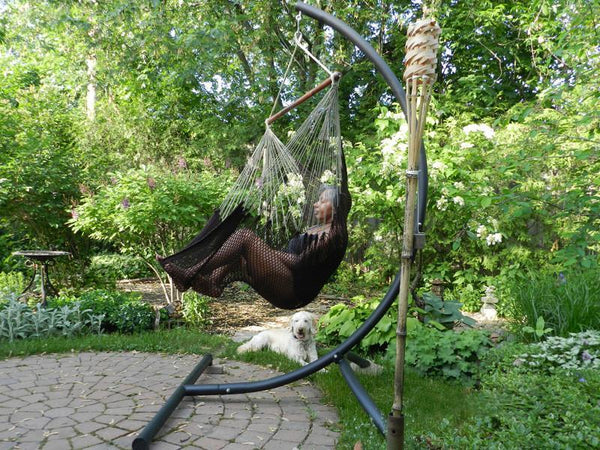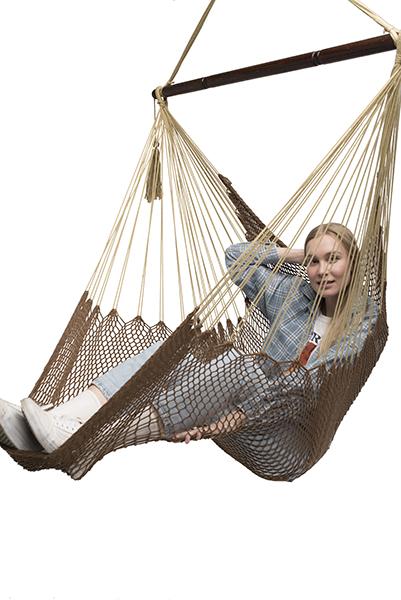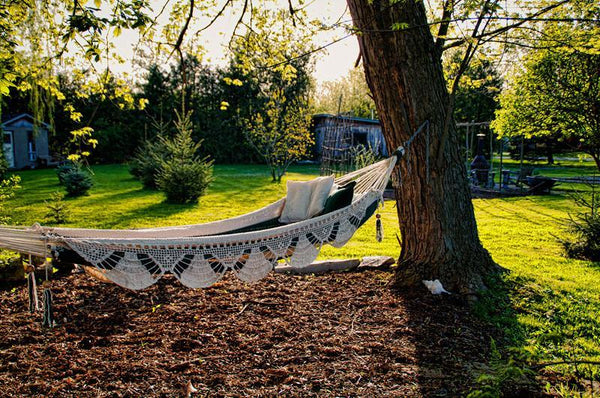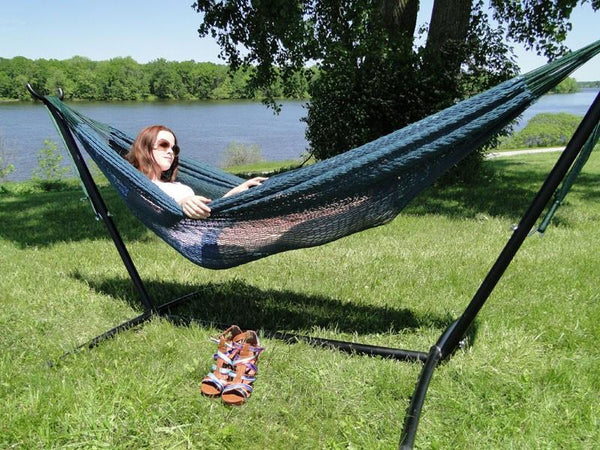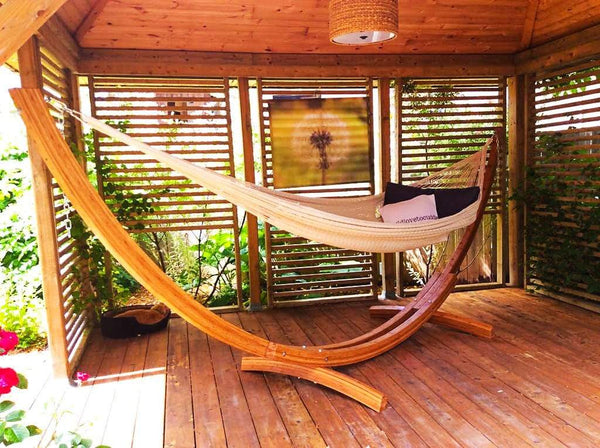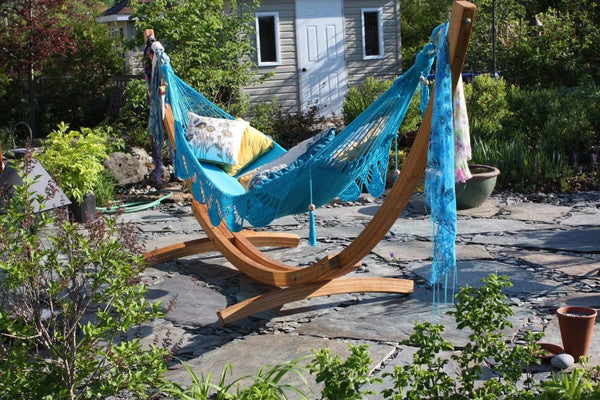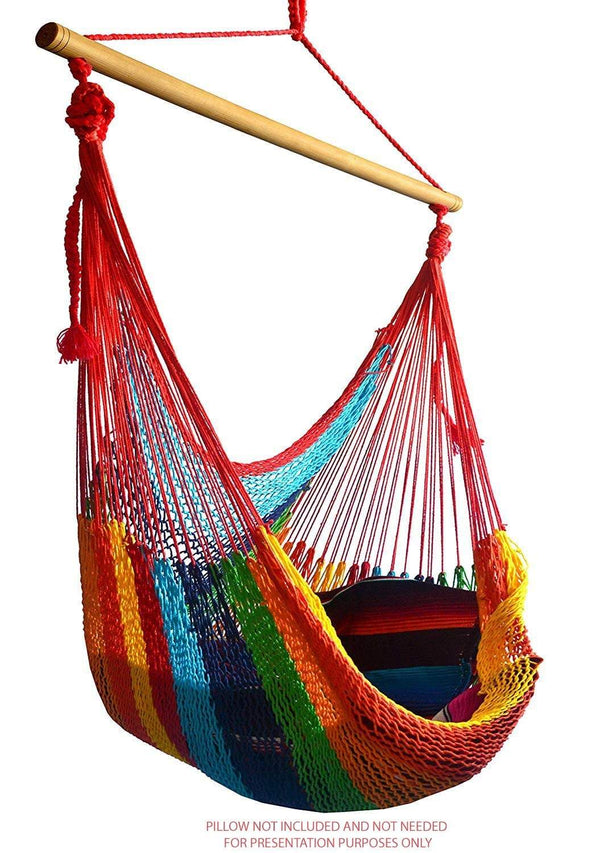FREE SHIPPING on most orders $25+ HAMMOCK BUYING GUIDE
Menu
-
-
Hammocks
-
Hammock Stands
-
Hammocks with Stands
-
Hanging Hammock Chairs
- View all Hammock Chairs
- Brazilian Style Hammock Chairs
- Colombian Hammock Chairs
- Mayan Hammock Chairs
- Mayan Hammock Chairs Deluxe
- Universal Hammock Chair Stand
- U Hammock Chair Stand
- Brazilian Hammock Chair with Universal Chair Stand
- Colombian Hammock Chair with Universal Chair Stand
- Mayan Hammock Chair with Universal Chair Stand
- Mayan Hammock Chair Deluxe with Universal Stand
-
Accessories
- Gift Cards
- Tools and Guides
- Bargain Bin
-
- 1-800-207-4761
- Login

FREE SHIPPING on most orders $25+ HAMMOCK BUYING GUIDE
The Art of Lounging - A Journey Through Time and Comfort
February 16, 2024 10 min read
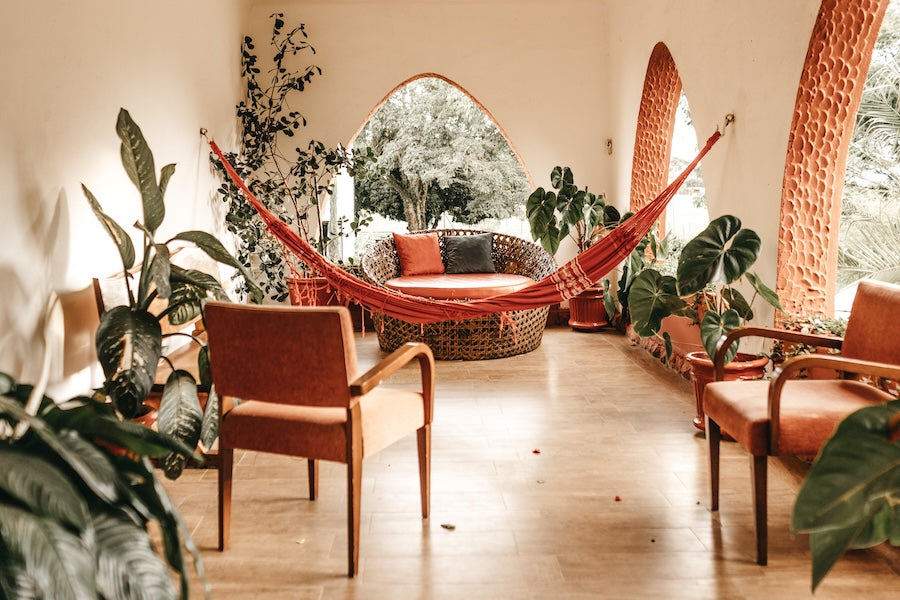
Audio Version
When the mercury dips and the snow softly blankets the streets, you, like many Canadians, might find yourself seeking the cosy confines of home. February's chill invites us to create sanctuaries indoors, where warmth and comfort are paramount. It's the perfect time to embrace the art of lounging—a universal form of relaxation that transcends time and space.
Have you ever wondered how the concept of lounging evolved?
It's a story that stretches back to the chaise lounges of ancient Egypt, winds through the opulent halls of Roman villas, and finds its way into the modern urban retreats.
Throughout history, cultures around the world have valued the importance of relaxation and leisure, and the ways they've embedded these ideals into their daily lives are both fascinating and inspiring.
Let's travel back to the origins of leisurely repose and discover how lounging has become a treasured slice of life. We'll also see how this ancient practice has been reimagined in contemporary times, thriving even in the heart of bustling cities.
The humble hammock, a symbol of relaxation that can be traced back centuries, still swings in the realm of modern relaxation, offering a versatile solution in the eternal quest for tranquility—whether strung up between two trees or cradling you in the comfort of your living room.
Settle in, wrap yourself up in a warm blanket, and let's start our journey through the annals of lounging, uncovering its rich tapestry woven into the very fabric of human history. It's an adventure that celebrates our collective need to unwind, reflect, and simply be, confirming that sometimes, the art of doing nothing is the most productive art of all.
The Origins of Lounging: Ancient Civilizations
Picture yourself walking through the warm, golden sands of ancient Egypt, where the concept of leisure was not just an activity, but a fundamental aspect of life. Now, go back even further than the monumental pyramids and imagine the earliest lounging furniture - the chaise lounge.
These elongated chairs were the thrones of relaxation, reserved for the highest echelons of society. The chaise lounge, often ornately carved and richly adorned, was not merely a place to rest; it symbolized power, divinity, and the gods themselves. Pharaohs and queens would repose on these luxurious constructs, often situated in breezy courtyards or along the banks of the life-giving Nile.
Lounging in ancient times was a testament to one's social standing. The more elaborate your lounging setup, the higher your status in the societal hierarchy. During this era, the art of lounging was intertwined with the very fabric of civilization. It was a ceremonial practice, a way to commune with the divine, and a chance to display one's prominence through the act of deliberate and ostentatious relaxation.
Take a moment to visualize the grandeur of these lounges as spaces of tranquillity, away from the hustle of daily life. It's where strategies were pondered over, political alliances were forged, and the realm of the spiritual met the material world.
The ancient Egyptians understood the importance of leisure and its relationship to overall well-being, setting a precedent for generations to come.
The Roman and Greek Influence
As you meander through time, you find yourself immersed in the grandeur of ancient Rome and Greece, where lounging became a cultural institution.
The Romans, with their love for excess and the finer things in life, took the concept of relaxation to heart and made it a central feature of their daily existence. The triclinium, a dining room furnished with couches on three sides of a low table, was a testament to this.
Imagine reclining comfortably, savouring grapes, as discussions of philosophy, politics, and the events of the day unfolded around you. These gatherings weren't merely about dining; they were elaborate social rituals where the art of conversation was as important as the indulgence in culinary delights.
Similarly, the Greeks had their own version of the lounge, known as the kline. Used for both dining and sleeping, the kline was a multipurpose haven for the thinkers and dreamers of the time. Lounging was embedded in their social fabric, enabling the free flow of ideas and relaxation that accompanied the symposiums – a practice of gathering, drinking, and engaging in intellectual discourse.
These ancient societies didn’t just lounge; they elevated leisure to an art form, a pivotal component of their culture and daily routines. Homes were designed with spaces that facilitated leisure and comfort, signifying that a day's worth of hard work deserved its counterbalance in rest and relaxation.
Even in the pantheon of gods, there were deities associated with rest, leisure, and festivity; a divine endorsement of the need to pause and rejuvenate.
As you explore the Roman and Greek contributions to the art of lounging, you might see echoes of these practices in today’s society – the modern social gatherings, the shared meals, and above all, the universal need to find a moment's peace amidst our busy lives.
The Eastern Perspective: Relaxation in Asia
Let's visit the East now, where the traditions and rituals of relaxation are as diverse as the landscapes themselves. In the bustling streets of India, there's a humble piece of furniture that has stood the test of time—the charpoy.
This simple, woven bed is a fixture in many homes, serving as a place for community gatherings, afternoon naps, and nocturnal repose under the stars. With its sturdy legs and geometric patterns of ropes or straps, the charpoy represents an enduring legacy of craftsmanship and an anchor in the daily lives of millions.
As you envision the tranquil, orderly gardens of Japan, there's another element that exudes serenity—the tatami mat. Made of rice straw and soft rush, these mats define Japanese interiors, influencing decor and lifestyles with their minimalist aesthetic.
Tatami mats are not just a flooring material; they represent a way of life, where less is more, and the ground itself is a place for rest, social interaction, and the practice of traditional arts. In a Japanese home, you might find yourself seated on a tatami, a cup of green tea in hand, surrounded by the peaceful ambiance that invites contemplation and repose.
This Eastern approach to lounging extends into the sphere of wellness and meditation. It's not simply about physical comfort but also about cultivating inner peace. Their art of lounging is deeply connected to spiritual practices, with dedicated spaces in homes for yoga, meditation, and tea ceremonies—each designed to nurture the soul as much as the body.
In these moments of stillness, you can embrace the full spectrum of relaxation, from the physical to the metaphysical.
The Renaissance of Relaxation in Europe
Let's wind the clocks forward to Europe during the Renaissance, an era of rebirth in art, culture, and thought that also heralded a renaissance of relaxation techniques and furniture.
This period saw the emergence of more elaborate and ornamental lounging furniture—the predecessors to the modern day sofa and armchair. Wealthy patrons and nobility would commission pieces that were as much statements of artistic expression as they were functional. The furniture of this time was heavy, made of solid woods, and adorned with intricate carvings, luxurious fabrics, and plush cushions, signaling a new emphasis on comfort and leisure in the domestic sphere.
Imagine the resplendent salons and parlours where intellectuals, artists, and the aristocracy would gather. These were not only spaces for socializing but for deep contemplation, reading, and artistic pursuits.
With the flourishing of the arts, lounging become an integral part of the creative process. The linkages between comfort, leisure, and intellectual productivity became more evident, setting a cultural precedent that continues to influence our approach to relaxation and work.
The literature and artwork from the Renaissance period are rife with depictions of lounging—nymphs resting in enchanted groves, scholars deep in study, and scenes of courtly love, all set against backdrops that celebrate the act of leisure.
These images are a window into a society that began to see leisure as not only desirable but essential, a balance to the rigours of intellectual and artistic labor. The Renaissance left a lasting imprint on the concept of lounging, marrying comfort with beauty and function with form in a way that continues to resonate in our homes today.
The Modern Lounging Revolution
As the wheels of history turned, heading into the bustling lanes of the Industrial Revolution, an interesting shift occurred.
Lounging, once the preserve of the privileged few, began to be democratized.
The power of mass production and the rise of a burgeoning middle class meant that what were once luxuries became part of everyday life. Suddenly, an array of lounging options sprouted up in homes across Europe and America, offering comfort to a wider audience than ever before.
The industrial era brought with it innovations in materials and manufacturing processes that changed the way furniture, including lounging items, was made and sold. Can you imagine your ancestors, crafting a space in their homes—no matter how humble—for the singular purpose of leisure?
Sofas, armchairs, and yes, even the occasional hammock, found their way into the family parlour, inviting weary workers and their families to take a moment for themselves. The idea that everyone deserved a spot to rest and recuperate after a day's labor became a widely accepted notion.
It was during this time that the hammock, woven into the fabric of maritime life for centuries, began to capture the imagination of people looking for new ways to relax.
The very same design that cradled sailors through tumultuous seas was now seen swaying in the gentle breezes of suburban backyards and public parks. This simple net or canvas suspended between two points offered a new form of relaxation that was as much about enjoyment as it was about function.
Hammocks: From Seafarers to Backyard Staples
The story of the hammock is as captivating as it is practical. Born from the need for sailors to sleep above the ground to avoid pests and moisture inside ships, hammocks quickly became essential for life at sea. The swinging motion provided a comfortable sleep even as waves crashed against the ship's hull—a feature that made hammocks indispensable for naval voyages.
But the hammock's journey didn’t end at the docks.
As sailors returned from distant shores, they brought with them tales of this uniquely comforting sling. It wasn’t long before these maritime beds found a new purpose on terra firma. Can you picture the tranquility of lying in a hammock, suspended in your own backyard, a gentle breeze swaying you into a state of bliss? That was the picture that captured the hearts of many, transforming the hammock from a seafarer's berth to an emblem of leisure and relaxation.
Across North America and elsewhere, hammocks began to symbolize the laid-back lifestyle that many aspired to. They evoked images of lazy afternoons with a good book, long summer evenings gazing at the stars, and the sweet indulgence of doing absolutely nothing.
This love affair with hammocks burgeoned into a culture of its own. They became not just a product, but a passport to serenity, a means to reclaim a slice of leisure in the ever-accelerating pace of modern life.
Entwined with this evolution into the perfect backyard accoutrement, hammocks also maintained a certain allure that's tied to their bohemian roots and the romance of adventure on the high seas. They bring to your own personal space a touch of that wanderlust, a reminder of a world beyond the confines of our day-to-day existence—a sentiment that's surely as welcome as the hammock itself in inviting you to stop and savour the moment.
The Urbanization of Lounging
As cities rise with the hustle of footsteps and the cacophony of traffic, the quest for tranquility becomes more fervent.
In the concrete jungle, space is a precious commodity, and with urbanization, our lounging habits have adapted to fit the confines of smaller living quarters. Enter the realm of compact and versatile furniture, where every piece must be both functional and space-efficient. Enter hammock chair—a slice of leisure that combines the swing of a hammock with the smaller footprint of a chair, fitting perfectly in a cosy corner or on a modest balcony.
This transformation of lounging spaces reflects an intimate understanding of the urban dweller's yearning for relaxation amidst the density of city life. Balconies, rooftops, and even tiny patches of green become personal havens, where hammock chairs and foldable loungers are not just decor but vital for carving out a personal sanctuary.
The trend is unmistakable; urbanites are creating these relaxation nooks with as much care as they select their wardrobes, seeking a blend of style and comfort that speaks to their individuality and need for a personal escape.
You’ll notice this trend in the growing popularity of communal spaces designed for pause and leisure too—a reflection of the human need to connect and unwind. From parklets dotted with benches to public gardens where hammocks hang invitingly between trees, the urban environment is being reimagined to accommodate the timeless art of lounging.
It's an evolution that balances the brisk pace of city life with moments of stillness and joy.
Embracing Indoor Relaxation: Lounging in Today's Canadian Homes
In the heart of a Canadian winter, with its pearlescent snowscapes and frost-laced windows, the call to embrace indoor warmth is compelling. Now, more than ever, your home is your refuge, and the adaptability of the hammock shines through.
Envision the transformation of your living room or that spare nook under the stairs into a snug hideaway, complete with a hammock that cradles you in its embrace. It's not just about the allure of swinging gently as you dive into a good book or sip your morning coffee—it's about creating an indoor oasis that brings the essence of leisure into your home.
Hammocks, with their graceful contours and inviting presence, offer more than just a place to lounge; they provide a tactile and visual experience that can enhance your indoor ambiance. The versatility of these pieces means you can integrate them seamlessly into your decor, whether you are drawn to the vibrant patterns that echo tropical paradises or the natural fibers that speak of earthy tranquility.
And when it comes to functionality, hammocks are unrivalled in their ability to be set up and taken down, making them perfect for moments when you crave leisure without sacrificing space.
Beyond their aesthetic and practical benefits, hammocks stand as a testament to the evolving nature of leisure culture. They bridge the gap between the need for personal solace and the social aspect of relaxation, where your home becomes the canvas for both.
The soul of lounging has always been about finding balance—between activity and repose, between the private and the communal. And in today's fast-paced world, where every minute is accounted for, the ability to pause, to rest, to simply be, is not just a luxury but a necessity.
So as the days remain shorter and the night's longer, consider how the simple act of lounging can enrich your life. There's an art to doing nothing at all, and within the gentle sway of a hammock, you'll find a piece of history, a touch of adventure, and an invitation to unwind that's as relevant today as it was in the lush gardens of ancient civilizations.
Whether you're nestled indoors away from the winter's chill or basking in the summer sun, remember that the essence of lounging is timeless, and the quest for comfort and tranquility is an enduring facet of the human experience.
Related Products
Want to relax?
Join for exclusive content and promotions we only give to our email list!
